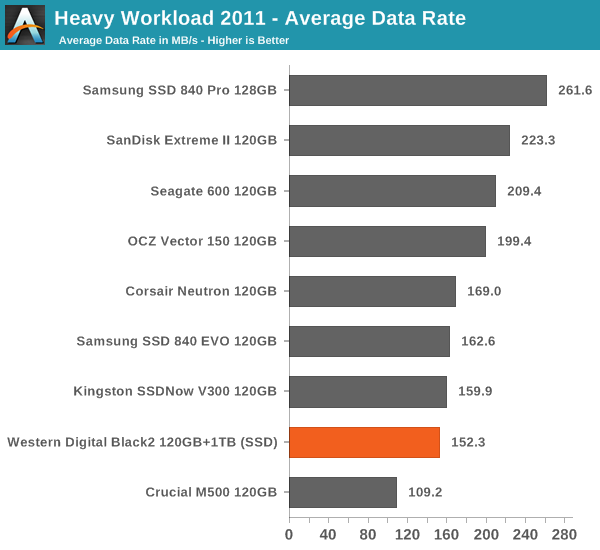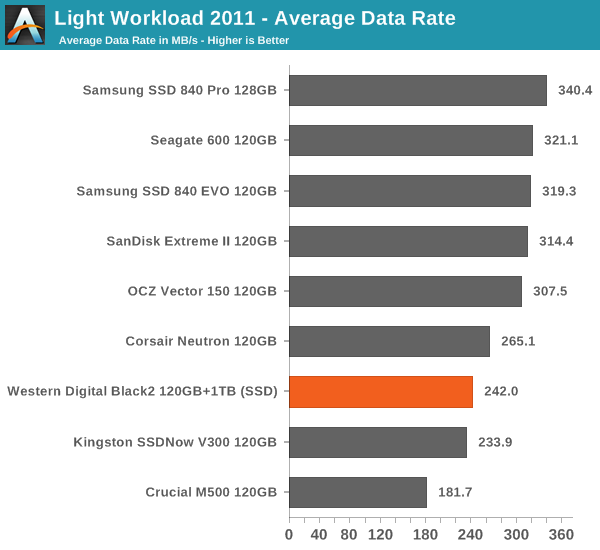The WD Black2 Review: World's First 2.5" Dual-Drive
by Kristian Vättö on January 30, 2014 7:00 AM ESTAnandTech Storage Bench 2011
Two years ago we introduced our AnandTech Storage Bench, a suite of benchmarks that took traces of real OS/application usage and played them back in a repeatable manner. The MOASB, officially called AnandTech Storage Bench 2011 - Heavy Workload, mainly focuses on peak IO performance and basic garbage collection routines. There is a lot of downloading and application installing that happens during the course of this test. Our thinking was that it's during application installs, file copies, downloading and multitasking with all of this that you can really notice performance differences between drives.
We tried to cover as many bases as possible with the software incorporated into this test. There's a lot of photo editing in Photoshop, HTML editing in Dreamweaver, web browsing, game playing/level loading (Starcraft II & WoW are both a part of the test) as well as general use stuff (application installing, virus scanning). We've included a large amount of email downloading, document creation and editing as well. To top it all off we even use Visual Studio 2008 to build Chromium during the test.
The test has 2,168,893 read operations and 1,783,447 write operations. The IO breakdown is as follows:
| AnandTech Storage Bench 2011 - Heavy Workload IO Breakdown | ||||
| IO Size | % of Total | |||
| 4KB | 28% | |||
| 16KB | 10% | |||
| 32KB | 10% | |||
| 64KB | 4% | |||
Only 42% of all operations are sequential, the rest range from pseudo to fully random (with most falling in the pseudo-random category). Average queue depth is 4.625 IOs, with 59% of operations taking place in an IO queue of 1. The full description of the test can be found here.
AnandTech Storage Bench 2011 - Heavy Workload

AnandTech Storage Bench 2011 - Light Workload
Our light workload actually has more write operations than read operations. The split is as follows: 372,630 reads and 459,709 writes. The relatively close read/write ratio does better mimic a typical light workload (although even lighter workloads would be far more read centric). There's lots of web browsing, photo editing (but with a greater focus on photo consumption), video playback as well as some application installs and gaming.
The I/O breakdown is similar to the heavy workload at small IOs, however you'll notice that there are far fewer large IO transfers.
| AnandTech Storage Bench 2011 - Light Workload IO Breakdown | ||||
| IO Size | % of Total | |||
| 4KB | 27% | |||
| 16KB | 8% | |||
| 32KB | 6% | |||
| 64KB | 5% | |||











100 Comments
View All Comments
Gigaplex - Thursday, January 30, 2014 - link
Once the partitions are set, do they show up in a different Windows box that doesn't have the drivers installed? If so, they're not really drivers, they're just a one-off utility to create the partitions.arturoh - Friday, January 31, 2014 - link
It does sound like the WD "driver" just sets up the partition table in MBR to point to the correct places. It'd be nice if WD provides a Linux utility or, even better, gives steps using existing Linux tools to correctly setup the MBR.arturoh - Friday, January 31, 2014 - link
I'd like know if WD plans to provide a utility to set it up under Linux.Guspaz - Thursday, January 30, 2014 - link
SATA expanders demonstrate that most chipsets do support multiple devices per SATA port.oranos - Thursday, January 30, 2014 - link
SSD is pretty much standard. HDD is too much of a bottleneck in performance system now.kepstin - Thursday, January 30, 2014 - link
I'm rather curious whether this dual drive would show up correctly, with space from both disks available, in Linux.Not that I would pick it up, I've already gone the dual drive route with a SanDisk extreme II and a hard drive in the (former) optical bay.
Kristian Vättö - Thursday, January 30, 2014 - link
It does.Panzerknacker - Thursday, January 30, 2014 - link
Like I said above, it should, and it's the reason I think it should not require a driver. Would be nice if this can be tested. If someone is gonna test this, please use a OLDER linux distro to make sure that there is no specific driver included.calyth - Thursday, January 30, 2014 - link
If they required a driver for windows so that the 2 drives shows up on the same partition table, I wouldn't count on Linux support yet.Unless WD sends a bunch to some linux hw devs ;)
Maltz - Thursday, January 30, 2014 - link
Except that it works fine on a Mac without drivers... once it's partitioned in Windows. I suspect the driver is only important or needed in the partitioning process.